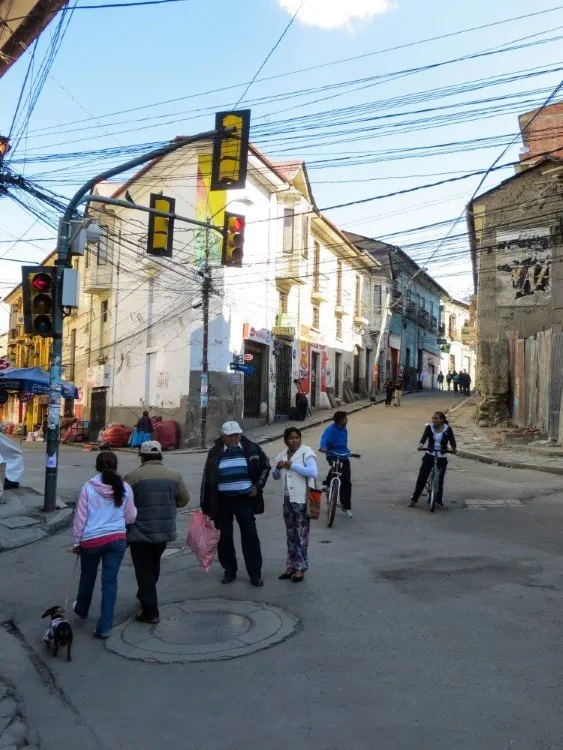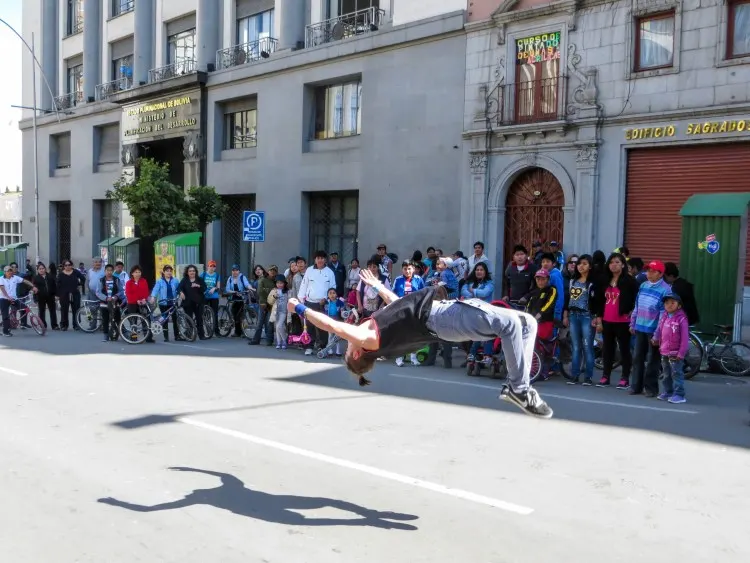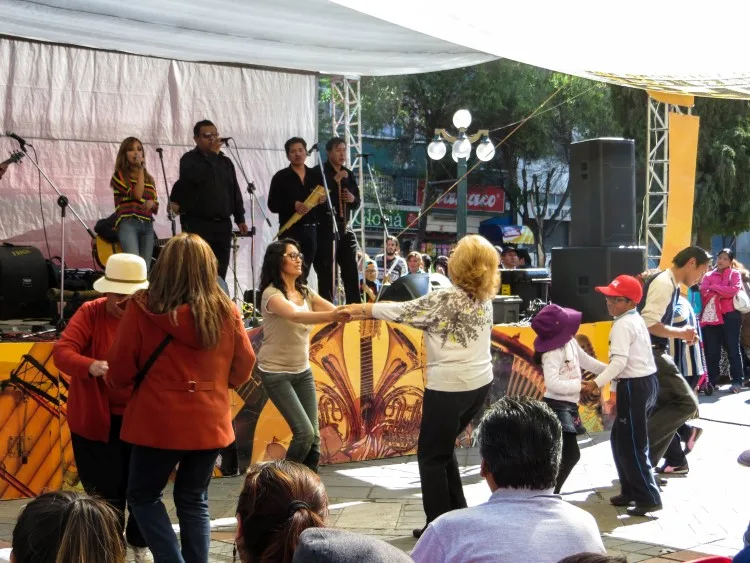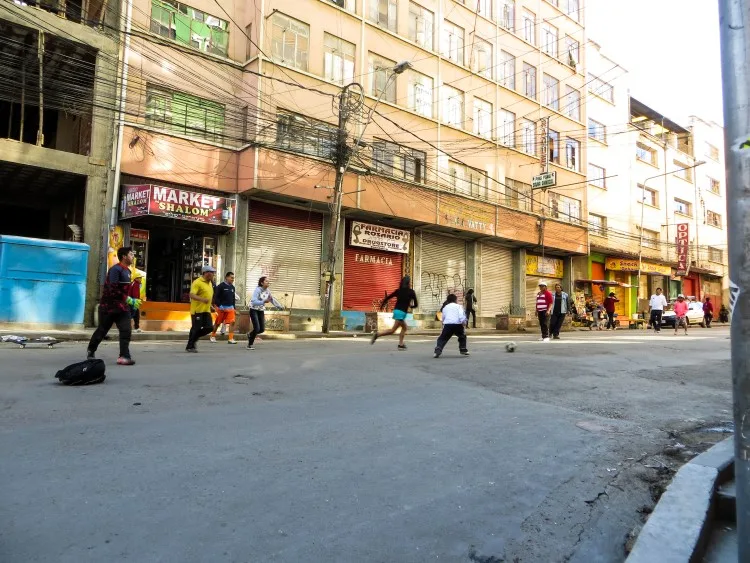One Sunday, I woke to the strangest of sounds.
From my hostel bed on a busy street in La Paz, I was normally jolted awake by the blaring chaos of the city: cars beep a relentless tune as they narrowly skirt around one another, avoiding multiple potential collisions every second.
Each morning at 6 am, the shrill pronouncement of the garbage van heralds the new day.
But that Sunday, I woke to a different backdrop: silence.
‘Dia de los Peatones’ or ‘Day of the Pedestrians’ is an annual event in La Paz and the rest of Bolivia.
The concept is simple: no vehicles can move around cities from 6 am until 6 pm. For La Paz, a city renowned for the frenetic, often dangerous energy of its traffic, the effect is startling.
Life in this city is frenzied: from the jostling, narrow streets overladen with cars up to the city as a collective whole. La Paz is a spectacular feat of urban planning (if, indeed, there ever was any).
From El Alto, overlooking the city from its vantage point at the brim of the vast plateau that stretches towards Lake Titicaca and the border with Peru, the city undulates in waves of terracotta brick and unfinished buildings, spilling down into the valley below before it reaches Zona Sur.

Presiding over this chaos are snowy peaks of Illimani, a 6,438 m giant that looms ominously in the distance.
In the densely-packed streets of this city, taxis and micros jostle past one another in traffic jams, avoiding any concept of lanes as they power at breakneck speed into any available space.
Pedestrians have no choice but to weave between the mêlée, assuredly offering their lives up to the will of the drivers as they do so.
If you have ever visited La Paz, it would be fair to say that a day without vehicles – and one that is, instead devoted to the local residents – is almost hard to imagine.

That morning I watched with interest from my bed – an excellent vantage point over the scene below.
The silent streets resembled what I can only suppose it is like in the aftermath of a bomb: tentatively, people began to appear, seemingly shell-shocked by the eerie silence that now filled the void where once there were vehicles.
They couldn’t quite believe their luck: the normally life-or-death act of crossing the city’s congested roads – forced to skim past market stalls and other pedestrians, all the while avoiding the erratic passage of traffic – disappeared.
[perfectpullquote align=”left” cite=”” link=”” color=”” class=”” size=””]The silent streets resembled what I can only suppose it is like in the aftermath of a bomb: tentatively, people began to appear, seemingly shell-shocked by the eerie silence that now filled the void where once there were vehicles.[/perfectpullquote]
Instead, people strolled purposefully into the centre of streets, pushing prams, kicking footballs and holding hands with their children as the possibilities of the city, released from the powerful grip of cars for the day, became apparent.
Others stopped to chat to neighbours and friends in the middle of crossroads, owning, in that moment, the road that normally owned them.
When I stepped out onto the streets myself, it was not only the magical silence that hit, but the atmosphere of contended, peaceful enjoyment.
I don’t think I’ve ever before spent such a calm, pleasant day in La Paz.
I too revelled in the chance to walk in the centre of the road – admittedly pausing at every crossing as the expectation of being bowled over by a car was hard to shake off – delighting at the little boy learning to ride his bike with his father, or the procession of skateboarders who embraced the empty, steep streets to race through the winding passages.
Their wheels filled the air with an echoing rumbling as they sped past.

On the Prado, one of La Paz’s main streets, the contrast between normal life was even more apparent. Here, those same skateboarders had taken full advantage of the momentarily empty space to perform tricks and leap over ever-higher barriers to the delight of the crowd. F
urther along, an exercise class was taking place, led by two men from a stage; the assembled audience following their movements in a commendable attempt at synchronisation.
Whole families moved between the different activities, stopping to finger-paint at a stall or eat at one of the restaurants which had spilled its chairs and tables out onto the street for the day, while dogs clothed in a variety of ridiculous outfits ran in between their legs.
Further down the Prado, a band were performing at another stage, the notes of traditional Bolivian music played on panpipes, wooden flutes and guitars mingling into the afternoon.
Members of the crowd caught up in the jubilation of the strange day formed pairs to join the Cueca Paceña, a traditional dance where handkerchiefs are twirled around the dancers’ bodies and heads. The crowd clapped and sung along to the music of their nation.

[perfectpullquote align=”right” cite=”” link=”” color=”” class=”” size=””]Weaving throughout was the constant face of poverty, those for whom today was like no other; a relentless drive to obtain enough money to eat. Yet their presence in among the crowds was almost obscured by the middle-class enjoyment of that Sunday.[/perfectpullquote]
In the narrower, higher parts of the city, families had taken over entire streets for games of football – the ball shooting into shop doors or landing on the heads of spectators in the euphoric chaos of the empty roads. Onlookers sat on the edges of pavements, breathing in the celebrations.
Across the city, it seemed like the Paceñans were being offered the chance – for one day only – to live the life that many wished they could; a city safe for their children and where the people, not the traffic, ruled.
Yet as ever is the case in this country, not everyone had the luck to enjoy the freedom which the silencing of the traffic had granted.
Weaving throughout was the constant face of poverty, those for whom today was like no other; a relentless drive to obtain enough money to eat.
Yet their presence in among the crowds was almost obscured by the middle-class enjoyment of that Sunday.

A small girl selling balloons wandered through the dancing audience, almost oblivious to the jubilation of the surrounding crowd.
A man – aged by poverty and hardship – set up a stall on the pavement, his child carefully lining up her prized cuddly toys beside the empty plastic cup, set out to collect donations from passers-by.
On reflection, El Dia de los Peatones was perhaps one of the strangest days I have experienced in my ten months in Bolivia.
Persistent noise is a daily feature of life in any city in this nation, and a day where this was silenced was a welcome relief for the many visitors in La Paz, let alone for the local people who endure the clamour of city life each and every day.
It was a shame that at 5:50 pm, business slowly returned to normal. Engines were ignited and vehicles began to reclaim the streets, almost cautiously, as if coming out of hiding.
La Paz was restored to its disorderly self once more.
